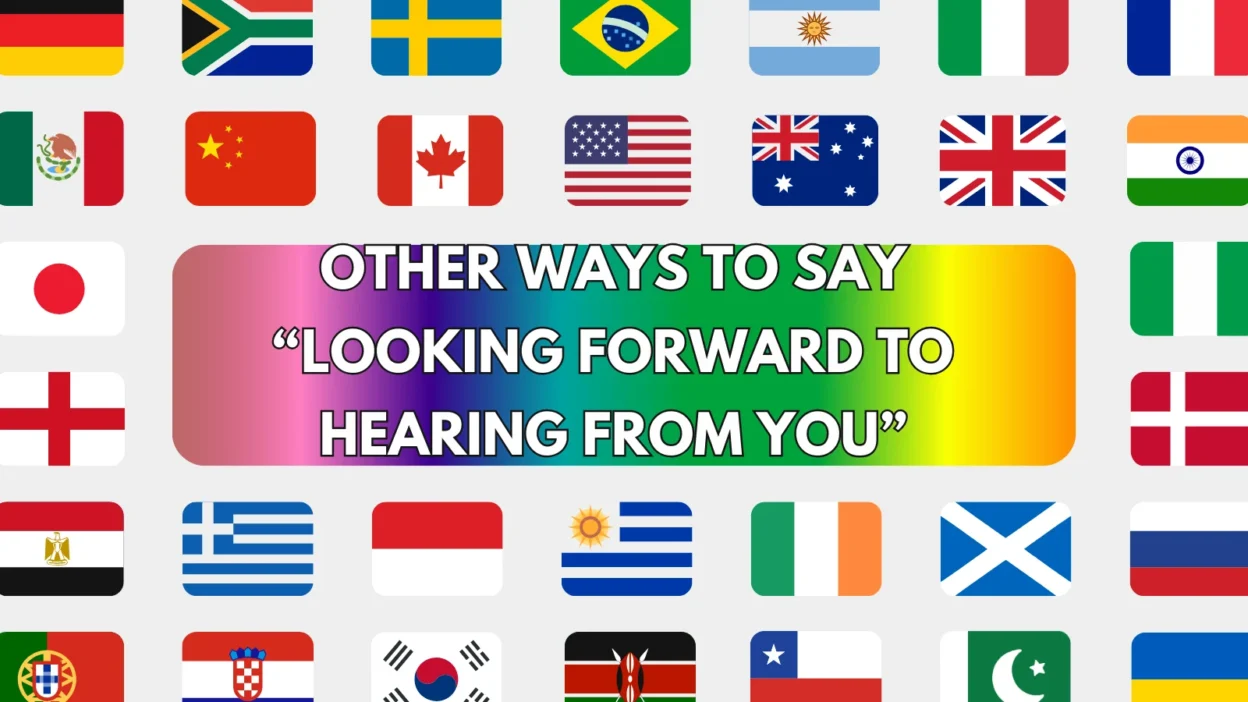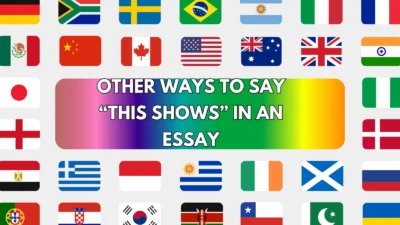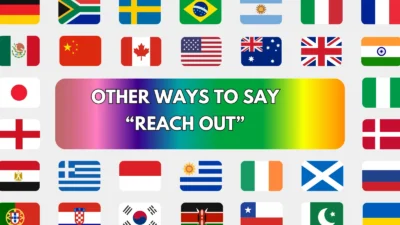“Looking forward to hearing from you” is one of the most common and polite ways to end a professional or formal message. It’s respectful and expresses a desire for a response. However, using the same phrase repeatedly can sound repetitive or mechanical. To improve your communication, it’s valuable to use a variety of alternatives that match your tone and the nature of your relationship with the recipient.
Below are 25 polished alternatives to “Looking Forward to Hearing From You”, complete with explanations and examples to help you choose the perfect one for every context.
1. I Hope to Hear From You Soon
Meaning:
Expresses hope that the recipient will respond shortly.
Detailed Explanation:
This version adds a softer tone with a hint of anticipation and warmth.
Scenario Example:
Thank you for your time. I hope to hear from you soon regarding the next steps.
Best Use:
Professional emails, job applications.
Tone:
Warm, polite.
2. I Await Your Response
Meaning:
States that you’re expecting a reply.
Detailed Explanation:
More formal and direct, it suggests that a reply is necessary or expected.
Scenario Example:
I await your response regarding the proposed schedule.
Best Use:
Formal letters, legal or business communication.
Tone:
Professional, formal.
3. Please Let Me Know Your Thoughts
Meaning:
Invites the reader to share their opinion or feedback.
Detailed Explanation:
Encourages open communication while still sounding respectful.
Scenario Example:
Please let me know your thoughts on the attached proposal.
Best Use:
Collaborative emails, team discussions.
Tone:
Open, constructive.
4. I Look Forward to Your Reply
Meaning:
Expresses eagerness for a response.
Detailed Explanation:
A close variation of the original, slightly more formal and polished.
Scenario Example:
Thank you for your application. I look forward to your reply.
Best Use:
Customer service, business conversations.
Tone:
Professional, respectful.
5. I Look Forward to Your Response
Meaning:
Politely communicates that a reply is expected.
Detailed Explanation:
More formal and ideal for written communication that requires a definitive answer.
Scenario Example:
I look forward to your response concerning the event arrangements.
Best Use:
Business proposals, planning emails.
Tone:
Professional, neutral.
6. Awaiting Your Reply
Meaning:
States directly that you’re waiting for a response.
Detailed Explanation:
A more concise and somewhat passive phrase.
Scenario Example:
Awaiting your reply at your earliest convenience.
Best Use:
Follow-up emails, client communication.
Tone:
Formal, brief.
7. I’d Appreciate Your Feedback
Meaning:
Asks politely for an opinion or review.
Detailed Explanation:
This phrase adds a tone of humility and appreciation.
Scenario Example:
I’d appreciate your feedback on the draft I sent last week.
Best Use:
Creative work, collaboration.
Tone:
Appreciative, humble.
8. Kindly Respond When You Can
Meaning:
Asks for a reply with understanding of the person’s schedule.
Detailed Explanation:
Polite and flexible, showing respect for the recipient’s time.
Scenario Example:
Kindly respond when you can so we can finalize the dates.
Best Use:
Casual-professional emails.
Tone:
Gentle, understanding.
9. Hoping to Hear From You Soon
Meaning:
A warm, optimistic version of the original phrase.
Detailed Explanation:
Adds friendliness and is suitable for both personal and business writing.
Scenario Example:
Hoping to hear from you soon about the internship.
Best Use:
Job applications, polite inquiries.
Tone:
Hopeful, friendly.
10. I’d Love to Hear Your Thoughts
Meaning:
Requests honest feedback or input.
Detailed Explanation:
Feels warm and engaging, great for building rapport.
Scenario Example:
I’d love to hear your thoughts on how we can improve the process.
Best Use:
Team discussions, creative proposals.
Tone:
Open, personal.
11. Looking Forward to Your Feedback
Meaning:
Expresses eagerness for input or comments.
Detailed Explanation:
This version is great when you want insights or critique.
Scenario Example:
Looking forward to your feedback on the marketing strategy.
Best Use:
Professional collaborations.
Tone:
Encouraging, professional.
12. Please Don’t Hesitate to Reach Out
Meaning:
Invites communication freely and openly.
Detailed Explanation:
Encourages continued conversation and removes pressure.
Scenario Example:
If you have any questions, please don’t hesitate to reach out.
Best Use:
Customer service, mentorship, onboarding.
Tone:
Reassuring, friendly.
13. I’m Eager to Hear From You
Meaning:
Shows enthusiasm about continuing the conversation.
Detailed Explanation:
This phrase adds a touch of excitement and genuine interest.
Scenario Example:
I’m eager to hear from you about the upcoming opportunity.
Best Use:
Networking, interview follow-ups.
Tone:
Positive, enthusiastic.
14. Can’t Wait to Hear Back From You
Meaning:
Expresses high anticipation of a response.
Detailed Explanation:
Less formal, best for colleagues or friendly business relationships.
Scenario Example:
Can’t wait to hear back from you about your availability!
Best Use:
Friendly or internal communication.
Tone:
Casual, excited.
15. Let Me Know What You Think
Meaning:
Requests an opinion or reaction.
Detailed Explanation:
Short, to the point, and great for creative or informal contexts.
Scenario Example:
Let me know what you think of the new layout.
Best Use:
Design feedback, internal collaboration.
Tone:
Informal, inviting.
16. I’ll Be Waiting for Your Response
Meaning:
Clearly states that you’re expecting a reply.
Detailed Explanation:
A bit more assertive, best used when a reply is truly needed.
Scenario Example:
I’ll be waiting for your response before moving forward.
Best Use:
Deadline-driven emails.
Tone:
Firm, respectful.
17. Let Me Know If You Need Anything Else
Meaning:
Opens the door for further questions or discussion.
Detailed Explanation:
Great customer-focused phrase to keep the conversation open.
Scenario Example:
Let me know if you need anything else to proceed.
Best Use:
Client communication, support roles.
Tone:
Helpful, approachable.
18. Looking Forward to Your Thoughts
Meaning:
Invites the reader to share ideas or feedback.
Detailed Explanation:
A refined version used in professional or creative conversations.
Scenario Example:
Looking forward to your thoughts on the report’s findings.
Best Use:
Team discussions, collaborative writing.
Tone:
Open, professional.
19. Let Me Know Your Availability
Meaning:
Requests schedule information for follow-up.
Detailed Explanation:
More task-focused, useful for planning meetings or calls.
Scenario Example:
Let me know your availability for a quick call this week.
Best Use:
Scheduling, coordination.
Tone:
Efficient, direct.
20. Awaiting Further Instructions
Meaning:
States you’re ready for the next step after a response.
Detailed Explanation:
Used when you’re in a support or waiting position.
Scenario Example:
Awaiting further instructions on how to proceed with phase two.
Best Use:
Project handoffs, intern follow-ups.
Tone:
Formal, patient.
21. I’ll Be in Touch Again Soon
Meaning:
Ends the message while suggesting you will follow up again.
Detailed Explanation:
Reduces pressure while keeping communication open.
Scenario Example:
I’ll be in touch again soon if I don’t hear from you.
Best Use:
Gentle follow-ups, networking.
Tone:
Friendly, soft.
22. Let’s Keep the Conversation Going
Meaning:
Encourages further discussion or engagement.
Detailed Explanation:
Energetic and engaging, best when discussing ongoing topics.
Scenario Example:
Let’s keep the conversation going on how to boost engagement.
Best Use:
Brainstorming, strategy sessions.
Tone:
Motivational, warm.
23. Keep Me Posted
Meaning:
Asks the reader to provide updates over time.
Detailed Explanation:
Casual and easygoing, great for colleagues or friends.
Scenario Example:
Keep me posted on your progress!
Best Use:
Team chats, casual business updates.
Tone:
Relaxed, friendly.
24. Let’s Stay in Touch
Meaning:
Suggests ongoing communication or relationship.
Detailed Explanation:
Ideal for closing a conversation on good terms even if no reply is needed.
Scenario Example:
Let’s stay in touch about future opportunities.
Best Use:
Networking, event follow-ups.
Tone:
Sincere, positive.
25. I Appreciate Your Time and Look Forward to Your Input
Meaning:
Thanks the recipient and requests their perspective.
Detailed Explanation:
Combines gratitude with a polite call for response.
Scenario Example:
I appreciate your time and look forward to your input on the strategy plan.
Best Use:
Professional emails, thoughtful conversations.
Tone:
Grateful, formal.
Conclusion
Using the same closing phrase like “Looking forward to hearing from you” in every message can feel repetitive. These 25 thoughtful alternatives allow you to tailor your message tone, level of formality, and relationship with the recipient. Whether you’re writing to a client, coworker, or hiring manager, these expressions will keep your communication sharp, respectful, and professional.




